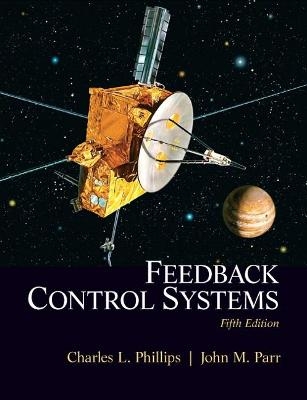
Feedback Control Systems
Pearson (Verlag)
978-0-13-186614-0 (ISBN)
This text offers a thorough analysis of the principles of classical and modern feedback control. Organizing topic coverage into three sections—linear analog control systems, linear digital control systems, and nonlinear analog control systems—helps students understand the difference between mathematical models and the physical systems that the models represent.
Professor John M. Parr received his Bachelor of Science degree in Electrical Engineering from Auburn University in 1969, an MSEE from the Naval Postgraduate School in 1974, and a PhD in Electrical Engineering from Auburn University in 1988. A retired U.S. Navy Officer, he served as a Program Manager/Project Engineer at Naval Electronic Systems Command in Washington, DC and Officer in Charge - Naval Ammunition Production Engineering Center, Crane, Indiana in addition to sea duty in five ships. Dr. Parr participated in research related to the Space Defense Initiative at Auburn University before joining the faculty at the University of Evansville. Dr. Parr is a co-author of another successful Electrical Engineering textbook, Signals, System and Transforms, by Phillips, Parr and Riskin. He is a registered professional engineer in Indiana, and is a member of the scientific research society Sigma Xi, the American Society of Engineering Educators (ASEE), and a Senior Member of the Institute of Electrical and Electronic Engineers (IEEE)
1 INTRODUCTION
1.1 The Control Problem
1.2 Examples of Control Systems
1.3 Short History of Control
References
2 MODELS OF PHYSICAL SYSTEMS
2.1 System Modeling
2.2 Electrical Circuits
2.3 Block Diagrams and Signal Flow Graphs
2.4 Masonís Gain Formula
2.5 Mechanical Translational Systems
2.6 Mechanical Rotational Systems
2.7 Electromechanical Systems
2.8 Sensors
2.9 Temperature-control System
2.10 Analogous Systems
2.11 Transformers and Gears
2.12 Robotic Control System
2.13 System Identification
2.14 Linearization
2.15 Summary
References
Problems
3 STATE-VARIABLE MODELS
3.1 State-Variable Modeling
3.2 Simulation Diagrams
3.3 Solution of State Equations
3.4 Transfer Functions
3.5 Similarity Transformations
3.6 Digital Simulation
3.7 Controls Software
3.8 Analog Simulation
3.9 Summary
References
Problems
4 SYSTEM RESPONSES
4.1 Time Response of First-Order Systems
4.2 Time Response of Second-order Systems
4.3 Time Response Specifications in Design
4.4 Frequency Response of Systems
4.5 Time and Frequency Scaling
4.6 Response of Higher-order Systems
4.7 Reduced-order Models
4.8 Summary
References
Problems
5 CONTROL SYSTEM CHARACTERISTICS
5.1 Closed-loop Control System
5.2 Stability
5.3 Sensitivity
5.4 Disturbance Rejection
5.5 Steady-state Accuracy
5.6 Transient Response
5.7 Closed-loop Frequency Response
5.8 Summary
References
Problems
6 STABILITY ANALYSIS
6.1 Routh-Hurwitz Stability Criterion
6.2 Roots of the Characteristic Equation
6.3 Stability by Simulation
6.4 Summary
Problems
7 ROOT-LOCUS ANALYSIS AND DESIGN
7.1 Root-Locus Principles
7.2 Some Root-Locus Techniques
7.3 Additional Root-Locus Techniques
7.4 Additional Properties of the Root Locus
7.5 Other Configurations
7.6 Root-Locus Design
7.7 Phase-lead Design
7.8 Analytical Phase-Lead Design
7.9 Phase-Lag Design
7.10 PID Design
7.11 Analytical PID Design
7.12 Complementary Root Locus
7.13 Compensator Realization
7.14 Summary
References
Problems
8 FREQUENCY-RESPONSE ANALYSIS
8.1 Frequency Responses
8.2 Bode Diagrams
8.3 Additional Terms
8.4 Nyquist Criterion
8.5 Application of the Nyquist Criterion
8.6 Relative Stability and the Bode Diagram
8.7 Closed-Loop Frequency Response
8.8 Summary
References
Problems
9 FREQUENCY-RESPONSE DESIGN
9.1 Control System Specifications
9.2 Compensation
9.3 Gain Compensation
9.4 Phase-Lag Compensation
9.5 Phase-Lead Compensation
9.6 Analytical Design
9.7 Lag-Lead Compensation
9.8 PID Controller Design
9.9 Analytical PID Controller Design
9.10 PID Controller Implementation
9.11 Frequency-Response Software
9.12 Summary
References
Problems
10 MODERN CONTROL DESIGN
10.1 Pole-Placement Design
10.2 Ackermannís Formula
10.3 State Estimation
10.4 Closed-Loop System Characteristics
10.5 Reduced-Order Estimators
10.6 Controllability and Observability
10.7 Systems with Inputs
10.8 Summary
References
Problems
11 DISCRETE-TIME SYSTEMS
11.1 Discrete-Time System
11.2 Transform Methods
11.3 Theorems of the z-Transform
11.4 Solution of Difference Equations
11.5 Inverse z-Transform
11.6 Simulation Diagrams and Flow Graphs
11.7 State Variables
11.8 Solution of State Equations
11.9 Summary
References
Problems
12 SAMPLED-DATA SYSTEMS
12.1 Sampled Data
12.2 Ideal Sampler
12.3 Properties of the Starred Transform
12.4 Data Reconstruction
12.5 Pulse Transfer Function
12.6 Open-Loop Systems Containing Digital Filters
12.7 Closed-Loop Discrete-Time Systems
12.8 Transfer Functions for Closed-Loop Systems
12.9 State Variables for Sampled-Data Systems
12.10 Summary
References
Problems
13 ANALYSIS AND DESIGN OF DIGITAL CONTROL SYSTEMS
13.1 Two Examples
13.2 Discrete System Stability
13.3 Juryís Test
13.4 Mapping the s-Plane into the z-Plane
13.5 Root Locus
13.6 Nyquist Criterion
13.7 Bilinear Transformation
13.8 RouthñHurwitz Criterion
13.9 Bode Diagram
13.10 Steady-State Accuracy
13.11 Design of Digital Control Systems
13.12 Phase-Lag Design
13.13 Phase-Lead Design
13.14 Digital PID Controllers
13.15 Root-Locus Design
13.16 Summary
References
Problems
14 DISCRETE-TIME POLE-ASSIGNMENT AND STATE ESTIMATION
14.1 Introduction
14.2 Pole Assignment
14.3 State Estimtion
14.4 Reduced-Order Observers
14.5 Current Observers
14.6 Controllability and Observability
14.7 Systems and Inputs
14.8 Summary
References
Problems
15 NONLINEAR SYSTEM ANALYSIS
15.1 Nonlinear System Definitions and Properties
15.2 Review of the Nyquist Criterion
15.3 Describing Function
15.4 Derivations of Describing Functions
15.5 Use of the Describing Function
15.6 Stability of Limit Cycles
15.7 Design
15.8 Application to Other Systems
15.9 Linearization
15.10 Equilibrium States and Lyapunov Stability
15.11 State Plane Analysis
15.12 Linear-System Response
15.13 Summary
References
Problems
APPENDICES
A Matrices
B Laplace Transform
C Laplace Transform and z-Transform Tables
D MATLAB Commands Used in This Text
E Answers to Selected Problems
INDEX
| Erscheint lt. Verlag | 15.3.2011 |
|---|---|
| Sprache | englisch |
| Maße | 187 x 233 mm |
| Gewicht | 1130 g |
| Themenwelt | Informatik ► Theorie / Studium ► Künstliche Intelligenz / Robotik |
| Technik ► Elektrotechnik / Energietechnik | |
| ISBN-10 | 0-13-186614-1 / 0131866141 |
| ISBN-13 | 978-0-13-186614-0 / 9780131866140 |
| Zustand | Neuware |
| Haben Sie eine Frage zum Produkt? |
aus dem Bereich


